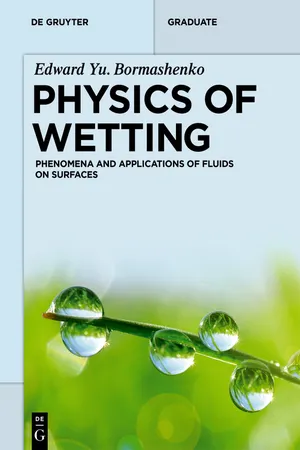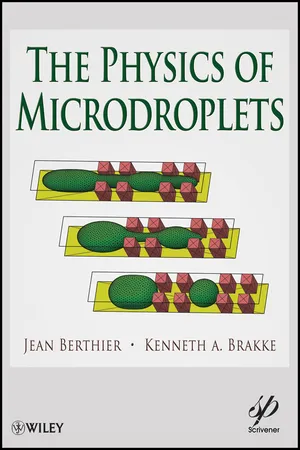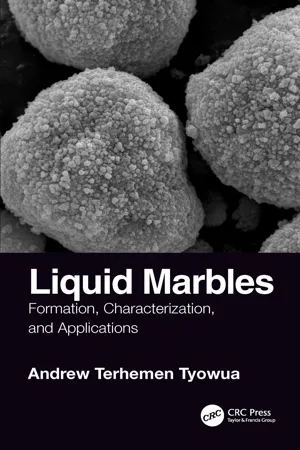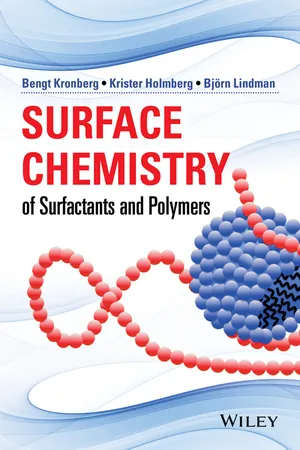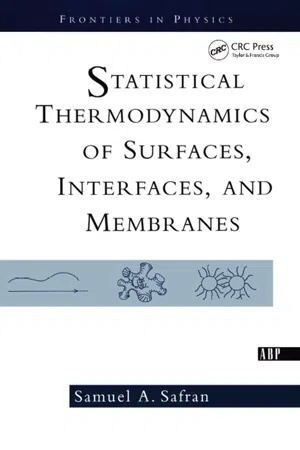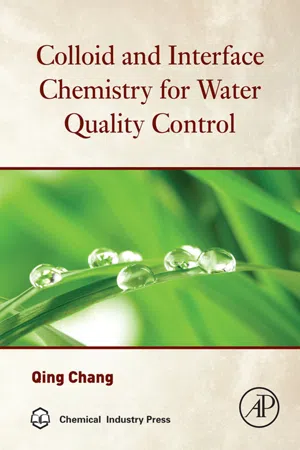Technology & Engineering
Surface Tension
Surface tension is the property of a liquid that causes its surface to behave like a thin, elastic sheet. It is due to the cohesive forces between the liquid molecules, which pull the molecules at the surface inward. This results in the formation of droplets and allows certain insects, like water striders, to walk on water.
Written by Perlego with AI-assistance
Related key terms
Related key terms
1 of 4
Related key terms
1 of 3
12 Key excerpts on "Surface Tension"
- eBook - ePub
- Edward Yu. Bormashenko(Author)
- 2017(Publication Date)
- De Gruyter(Publisher)
1What is Surface Tension?1.1Surface Tension and its definition
Surface Tension is one of the most fundamental properties of liquid and solid phases. Surface Tension governs a diversity of natural or technological effects, including floating of a steel needle, capillary rise, walking of water striders on the water surface, washing and painting. It governs many phenomena in climate formation, plant biology and medicine. Surface Tension is exactly what it says: the tension in a surface and the reality of its existence are demonstrated in Fig. 1.1 , which shows a metallic needle supported by water surface. The locomotion of water striders to be addressed in detail in Section 3.7 is another well-known manifestation of the Surface Tension-inspired phenomenon.Fig. 1.1: Manifestation of Surface Tension: steel needle floating on the water surface.Imagine a rectangular metallic frame closed by a mobile piece of wire as depicted in Fig. 1.2 . If one deposits a soap film within the rectangle, the film will want to diminish its surface area. Thus, it acts perpendicularly and uniformly on the mobile wire as shown in Fig. 1.2 . Surface Tensioncould be defined as a force per unit length of the wire.γ →The Surface Tension defined in this way is a tensor that acts perpendicularly to a line in the surface. Surface Tension is often identified with the specific surface free energy. Indeed, when the mobile rod l in Fig. 1.2 moves by a distance dx , the work 2γ ldx is done (factor 2 reflects the presence of upper and lower interfaces). Thus, the Surface Tension γ could be identified with the energy supplied to increase the surface area by one unit. This identification may give rise to misinterpretations: the Surface Tension defined as force per unit length of a line in the surface is a tensor , whereas specific surface free energy is a scalar thermodynamic property of an area of the surface without directional attributes [1 ]. However, for liquids at a constant temperature and pressure and in equilibrium, the Surface Tension is numerically equal and physically equivalent to the specific surface Helmholtz free energy [1 - Biman Bagchi(Author)
- 2018(Publication Date)
- CRC Press(Publisher)
Coexistence of two phases is a common phenomenon in nature. Most common examples include vapor on the surface of liquid water (as in lakes and oceans) and liquid and/or vapor in contact with solid, as in glaciers and partly frozen lakes. Whenever two different phases are brought together, a range of new phenomena and many new features appear that are not present in the bulk phases. Surface phenomena covers a wide range of topics, including (i) nucleation and growth, (ii) corrosion of metals, (iii) catalysis and surface reactions, (iv) biological surfaces like cell membranes, proteins and DNA in aqueous solutions, to name a few. In Statistical Mechanics we are interested in all these phenomena and in many associated problems. Central to our study of surface phenomena is the concept of Surface Tension, which is an important experimentally measurable property of the interface, and it controls many surface related phenomena. Surface Tension in turn is determined by the nature of the phase coexistence and properties such as the width of the density profile (at a gas-liquid or liquid-solid interface) and free energy variation as we traverse from one phase to the other. Conceptually and theoretically, this is a difficult subject to comprehend. A major success of Statistical Mechanics is the derivation of accurate expressions of Surface Tension. In this chapter we shall discuss some of these aspects of surface phenomena from a statistical mechanical view. Therefore, we shall not discuss catalysis or corrosion but such topics as structure of interfaces leading to observed values of Surface Tension.22.1 IntroductionThe physical origin of the Surface Tension is explained in Figure 22.1 . It is a consequence of intermolecular attraction and arises from unbalanced molecular cohesive forces at the surface . As a result of this unbalanced molecular cohesive forces, the molecules at the surface experience a net attraction towards one of the bulk phases, the one with higher density. This unbalanced force gives rise to a tension in the surface at equilibrium. The surface tends to contract (minimize) the surface area, while molecules in bulk experience no such anisotropic attraction [1 ,2 ].Figure 22.1A schematic illustration of molecular forces giving rise to Surface Tension. These forces are balanced inside the bulk liquid but remained imbalanced at surfaces due to different density and/or molecular arrangements. So, the surface in under tension.This is similar to the tension in a string when pulled from two sides in the opposite direction, as in a tug-of-war, or a vertically suspended string with a weight attached to its one end. Thus, the tension is a reaction of the string to the external force. It is created here by the unbalanced forces at the interface.Quantitatively, one defines Surface Tension as the work required to increase the surface area by unity. Surface Tension has the dimension of force per unit length or of energy per unit area [1 ,2 ].Surface Tension is responsible for the spherical shape of rain drops, soap bubbles, bubbles within boiling water, to name a few. The spherical shape serves to minimize the surface area of the drop and thus minimize surface energy. Many more fascinating consequences of Surface Tension are also ubiquitous in nature—for example, the floating of oil on the surface of water and the ability of some insects (e.g., water striders) to walk on the water surface.- eBook - ePub
- Jean Berthier, Kenneth A. Brakke(Authors)
- 2012(Publication Date)
- Wiley-Scrivener(Publisher)
An estimate of the Surface Tension can be found by considering the molecules’ cohesive energy. If U is the total cohesive energy per molecule, a rough estimate of the energy excess of a molecule at the interface is U /2. Surface Tension is a direct measure of this energy excess, and if δ is a characteristic molecular dimension and δ 2 the associated molecular surface area, then the Surface Tension is approximately (1.1) This relation shows that Surface Tension is important for liquids with large cohesive energy and small molecular dimension. This is why mercury has a large Surface Tension whereas oil and organic liquids have small Surface Tensions. Another consequence of this analysis is the fact that a fluid system will always act to minimize surface area: the larger the surface area, the larger the number of molecules at the interface and the larger the cohesive energy imbalance. Molecules at the interface always look for other molecules to equilibrate their interactions. As a result, in the absence of other forces, interfaces tend to adopt a flat profile, and when it is not possible due to boundary constraints or volume constraints, they take a rounded shape, often that of a sphere. Another consequence is that it is energetically costly to expand or create an interface: we will come back on this problem in Chapter 10 when dividing a droplet into two “daughter” droplets by electrowetting actuation. The same reasoning applies to the interface between two liquids, except that the interactions with the other liquid will usually be more attractive than a gas and the resulting dissymmetry will be less. For example, the contact energy (Surface Tension) between water and air is 72 mN/m, whereas it is only 50 mN/m between water and oil (table 1.1). Interfacial tension between two liquids may be zero: fluids with zero interfacial tension are said to be miscible - eBook - ePub
Liquid Marbles
Formation, Characterization, and Applications
- Andrew T. Tyowua(Author)
- 2018(Publication Date)
- CRC Press(Publisher)
Table 1.1 . A liquid surface is basically a liquid-air interface. The cohesive forces between the molecules of the liquids are greater than the adhesive forces between the air and the liquid molecules. The result is a force imbalance with a net inward force in the liquid bulk phase. This causes the liquid surface to stretch as though it were covered with an elastic membrane. This is the origin of Surface Tension in liquids. Surface Tension is responsible for many observed physical phenomena. For example, due to Surface Tension, liquid drops minimize their surface area by taking a spherical shape (geometry of least surface area). The rising of liquids in thin capillaries once submerged in them is also a consequence of Surface Tension. It is also because of Surface Tension that insects are able to walk on the surface of water.TABLE 1.1Surface Tension of Some Liquids at 25°CLiquid γla /mN m−1 at 25°CHexane 17.89 Ethanol 21.97 Methanol 22.07 Cyclohexane 24.65 Acetone 24.02 Chloroform 26.67 Acetic acid 27.10 Toluene 27.93 Benzene 28.22 Hexadecane 27.05 Formamide 57.02 Water 71.99 Source: Jasper, J.J., J. Phys. Chem. Ref. Data 1, 841–1009, 1972.1.2.2 CAPILLARITY AND WICKINGA liquid will either rise against gravity or fall in a thin capillary once submerged (vertically) in it, and the phenomenon is known as capillarity. The rise or fall is, however, dependent on whether the cohesive forces between the liquid molecules are higher than the adhesive forces between the liquid molecules and those of the capillary. For liquids that rise in thin capillaries, the adhesive forces are higher than the cohesive forces. The converse is true for liquids that fall in capillaries. This is the reason water rises in glass capillaries while mercury falls in them. When “rising” or “falling” stops in capillaries, the liquid-air interface in them curves inwardly (concave, e.g. water in glass capillaries) or outwardly (convex, e.g - eBook - ePub
- Bengt Kronberg, Krister Holmberg, Bjorn Lindman(Authors)
- 2014(Publication Date)
- Wiley(Publisher)
12 Surface and Interfacial TensionThe Surface Tension of liquids causes the formation of drops and is related to the attractive forces between the molecules (Figure 12.1 a). These attractive forces are the source of condensation of vapors into liquids and they originate from dispersion, dipole–dipole, dipole-induced dipole forces, and hydrogen bonding among others. In the bulk liquid, a molecule senses the same attractive forces in all directions, whereas for a molecule at the surface this attraction is lacking in one direction. This asymmetry is the origin of the surface energy and is manifested in the Surface Tension. Hence, the Surface Tension is a reflection of the cohesive forces in a liquid.(a) The origin of the Surface Tension is found in the imbalance of the attractive forces on a molecule at the surface. (b) Close to the surface the molecules are at larger separations and hence they have a higher energy, (c) as depicted in the energy versus distance diagramFigure 12.1A second, and a physically more correct, molecular explanation for the Surface Tension is depicted in Figure 12.1 b. Close to the surface the molecules are at larger separations and, hence, they have a larger energy, as depicted in the energy versus distance diagram in Figure 12.1 c. Also in this molecular picture, the Surface Tension correlates with the cohesive energy of the liquid.Examples of the Surface Tension for some neat liquids are shown in Table 12.1 . The Surface Tension is expressed in units of dyn/cm or mN/m. Fortunately, the conversion factor is unity in going from one unit to the other, so they can be used interchangeably. Since the Surface Tension is equivalent to a surface energy, or to be more correct, a surface free energy, the Surface Tension can also be expressed in energy units, erg/cm2 or mJ/m2 , again also with a conversion factor of unity. From Table 12.1 , we note that the Surface Tension correlates with the cohesion energy in the liquid as reflected in the solubility parameter (Chapter 9 - Samuel Safran(Author)
- 2018(Publication Date)
- CRC Press(Publisher)
2 Interfacial Tension 2.1 INTRODUCTIONOne possible approach to the development of new materials focuses on the mixing of the components on the molecular level. The study of such mixtures involves the chemistry and the statistical mechanics related to the microscopic interactions. Another approach is to combine the materials on mesoscopic scales, tens to hundreds of Angstroms; for solids, such mixtures are termed composites and for liquids they are termed dispersions. Although the local environment of most of the molecules is that of the pure bulk components, the macroscopic properties of the system can nevertheless be drastically modified. A fundamental understanding of the processes involved in this second approach to materials design involves the physics of the interfaces between the two components. Sometimes, one does not want to make a bulk dispersion or composite material, but rather desires to modify the surface of a given material by adsorbing one or more layers of another component. An understanding of this process involves the physics of the surface — its structure and possible phase transitions — and the statistical mechanics of adsorption. We shall use the term surface to indicate the boundary between a fluid or solid in equilibrium with its vapor (or a vacuum if the vapor is dilute enough) and the term interface to denote the boundary between two different solids or liquids. It is important to note that an interface between two components is often not a sharp discontinuity between them; the interface usually has a width of at least a molecular thickness. In this chapter, we consider a model interface between two coexisting phases in equilibrium. We discuss the concept of interfacial tension and calculate the free energy and composition profile as one goes from one phase, through the interface, to the other phase. We also discuss how the tension may be modified by the presence of interfacially active components. For profiles that show a rather sharp transition between the two phases, interfaces and surfaces are quasi-two-dimensional and their physical properties often reflect the effects of this reduced dimensionality (e.g- M J Lewis(Author)
- 1990(Publication Date)
- Woodhead Publishing(Publisher)
surface inactive. The first definition of Surface Tension is the force per unit length acting in a particular surface, acting at right angles to one side of a line drawn on the surface.Therefore the units of Surface Tension are newtons per metre (N m −1 ) or dynes per centimetre (dyn cm−1 ):=1 N1 m=10 5dyn10 2cm10 3dyncm− 1SI units are often expressed in terms of millinewtons per metre (mN m−1 ), where 1 mN m−1 = 1 dyn cm−1 .If a piece of string with the ends tied is laid out on a water surface in a random fashion (Fig. 6.1(c) ) and a surface-active substance, e.g. detergent, is added to the surface of the fluid enclosed by the string, then the string is subjected to outward forces due to the differences in Surface Tension, and it will assume a circular shape. Forces are acting at right angles to the surface for this to occur.Another way of viewing Surface Tension is in terms of the work required to extend a surface under isothermal conditions. Consider a box with two smooth wires A and B a distance d apart (Fig. 6.1(d) ), with a slider capable of moving along the wires to enclose a film within the framework of wires. A force of F needs to be applied to counteract the Surface Tension forces (i.e. a Langmuir balance (Levitt, 1973 ).At equilibrium,F = 2 γ d(Note that there are two points of contact between the wire and film.) If the slider is advanced to the right by a distance L m, the work done is FL. The surface area increases by 2Ld- eBook - ePub
- Ronald L. Panton(Author)
- 2024(Publication Date)
- Wiley(Publisher)
23 Surface Tension Effects Surface Tension is important in determining the shape of interfaces and in certain instances promoting flow within the bulk phases. First, we discuss some kinematic and mathematical aspects of surfaces. This is followed by the application of mass and momentum conservation laws and will result in relations between the flow properties on either side of the interface. In several sections we present analysis of the static menisci shapes. Stokes flow over a bubble and capillary waves is followed by the basic problem of coating flows, the drag-out problem. Coating flows contain moving contact lines, a subject that requires extra discussion. The chapter ends with the presentation of three Marangoni flows, flows that are driven by Surface Tension. 23.1 INTERFACE CONCEPTS AND LAWS The interface between a flowing liquid and a gas is difficult to define in an unambiguous manner. In general, there are absorbed molecules of various species and complex interactions that are not easily characterized with continuum properties. Moreover, the mathematics of a two-dimensional world embedded and interacting with a three-dimensional world is more advanced than we have been using (Aris, 1962; Slattery, 1990). Nevertheless, many useful engineering analyses can be accomplished with a simple model of the interface (see Table 23.1). Table 23.1 Properties of Interfaces in Various Coordinate Systems a Coordinates Interface Curvature, Interface Velocity, n w a n z is used to simplify terms. Assume that there is a surface with gas on one side and liquid on the other. The jump in density is a mathematical discontinuity and the density function is not defined at the interface. It is, in a certain sense, contrary to the assumption that fluid properties are continuously distributed in space. Essentially, we must make some special assumptions about the behavior of interfaces. A major assumption is that the interface itself contains no mass - Ali Danesh(Author)
- 1998(Publication Date)
- Elsevier Science(Publisher)
Developments in Petroleum Science , Vol. 47, Suppl. (C), 1998ISSN: 0376-7361doi: 10.1016/S0376-7361(98)80030-78 Interfacial TensionSurface forces affect fluid phase equilibria. A tension always exists at the interface of fluid phases, due to unbalanced molecular attractive and repulsive forces. For a pure compound, the vapour pressure over a meniscus in a pore which is concave toward the vapour phase is smaller than that over a flat surface and decreases as the radius of curvature decreases. Capillary condensation, where an unsaturated vapour forms condensate in tight pores is a manifestation of the above effect. It, however, becomes only significant in very tight spaces. It is generally neglected in reservoir engineering studies, because the rock in majority of gas condensate reservoirs is water wet, hence, the tight corners are filled with water and not open to the hydrocarbon. Surface forces, however, affect the onset of formation of new phases and also play a major role in multiphase flow in hydrocarbon reservoirs and in pipelines.A quantitative index of the molecular tension at the interface is the interfacial tension (IFT), σ, defined as the force exerted at the interface per unit length (mN/m = dyne/cm).The capillary pressure is the concept which is often used in reservoir studies to consider the effect of surface forces on the fluid distribution within a reservoir. The capillary pressure is related to the interfacial tension and the pore characteristics [1 ], It has been established also that the relative permeability, which describes the multiphase flow behaviour in the reservoir rock, may strongly depend on the interfacial tension [2 ]. The application of IFT dependent relative permeability in the dynamic evaluation of phase behaviour models will be described in Section 9.3- eBook - ePub
- Christos Ritzoulis(Author)
- 2013(Publication Date)
- CRC Press(Publisher)
line tension can be defined as the energy per unit length of the edge of a space that contains a substance. Line tension is expected to be larger than Surface Tension because the molecules that are found along the length of a line can form still fewer bonds, such as hydrogen bonds, with neighboring molecules. Line tension is observed at the edges of geometric shapes, for example, at the point of contact of a droplet with a surface.The shape of a droplet on a surface is spherical due to the attempt of the droplet to minimize the free surface area and because of the symmetrical distribution of forces. This is due to, among other things, the capillary phenomenon, as we will see later. The corresponding point tension has been described and studied theoretically.4.2 Interface tensionAs mentioned in the previous section, Surface Tension is the additional free energy per unit surface that results from the inability of the surface molecules to form interactions with other molecules in the direction of the empty space above the surface. If we bring two substances into contact in order to form two separate phases that are separated by an interface, then maybe the molecules of the two phases that are found at the interface can exert some forces between them. These forces may be weaker than those exerted between molecules of the same phase, but they can reduce somewhat the free surface energy. Thus, if we bring into contact two substances A and B with Surface Tensions γA and γB , respectively, then the interface tension γAB will be(4.7)γ=ABγ A+γ B− 2σABwhere σAB is the energy gain per surface unit area due to attractive interactions between the molecules of A and B. This equation shows that the free energy per unit area γAB is large when the Surface Tensions are large and the interactive forces between the phases are small.As each of the two populations of surface molecules A and B tends to retire to its respective bulk phase A or B, the two surfaces tend to dissociate from each other. The sum γA + γB quantifies the energy per unit area relevant to this dissociation. These two surfaces are mutually insoluble and will form a clear interface between them. At the macroscopic level, the two components A and B will phase separate. If one considers a second scenario where the forces between A and B increase and become comparable to the forces leading to phase separation, then Equation (4.7) becomes γA + γB = 2σAB . In this case, γab is zero and the surface energy is also zero. This will lead to conditions in which the two phases are thermodynamically compatible, the interface will break down, and complete mixing - Qing Chang(Author)
- 2016(Publication Date)
- Academic Press(Publisher)
Chapter 8Surface of Liquid
Abstract
This chapter presents the basic concepts of Surface Tension and surface free energy, including the origination of Surface Tension and surface free energy, the Surface Tension of common liquids, and the variation of Surface Tension with temperature and pressure. Based on the basic concepts, the relation between liquid pressure and surface curvature and the relation between vapor pressure of liquid and surface curvature are discussed. Many methods for measuring Surface Tension are outlined, but only capillary rise method and ring method are commonly used, therefore, these are discussed in detail. Cohesion work and adhesion work, the spreading of one liquid on another liquid, are described. For liquid–liquid interfacial tension, Fowkes et al. developed a semiempirical treatment which is valuable to be introduced here. Since surface film provides a very efficient method for water conservation, the insoluble monomolecular film is introduced, and the various states of monomolecular film are shown in detail.Keywords
Surface Tension surface free energy Surface Tension measurement cohesion work adhesion work spreading Fowkes theory monomolecular film water conservationChapter Outline8.1 Surface Tension and Surface Free Energy1378.1.1 Basic Concepts1378.1.2 Origination of Surface Tension and Surface Free Energy1388.1.3 Surface Tensions of Common Liquids1398.1.4 Variation of Surface Tension With Temperature and Pressure1398.2 Relation Between Liquid Pressure and Surface Curvature1418.3 Relation Between Vapor Pressure of Liquid and Surface Curvature1448.4 Contact Angle1468.5 Measurement of Surface Tension1468.5.1 Capillary Rise Method1468.68.5.2 Ring Method148- Rachid Ababou(Author)
- 2018(Publication Date)
- Wiley-ISTE(Publisher)
2 Two-Phase Physics: Surface Tension, Interfaces, Capillary Liquid/Vapor Equilibria2.1. Summary and objectivesThis chapter reviews the physical and mechanical concepts of capillarity, Surface Tension, interfaces, liquid/vapor equilibria, and more generally, the physical and thermo-dynamical concepts related to systems where several fluid phases co-exist. The emphasis on capillary physics corresponds to the main topic of the book (capillary flows, and porous media flows).First, we present in this chapter a broad overview of capillary effects in the environment and in man-made engineered systems. We then present basic physical concepts on capillarity and Surface Tension (or interfacial tension). This takes us from molecular scale physics, to a fluid scale description of the interface between two immiscible fluids at equilibrium, possibly in the presence of a solid phase1 .Finally, we end this chapter with additional sections focusing on thermos-dynamical aspects (Gibbs free energy or potential; Kelvin relation; etc.) – which may prove useful during the later stages of this book:- – the Gibbs potential can be used to explain and extend the concept of capillary pressure, and suction, for the case of relatively dry and/or clayey porous media (soils, rocks);
- – Kelvin’s thermodynamic relation is introduced as an auxiliary model for coupling the state of the atmosphere (air pressure, temperature, and vapor pressure or relative humidity), with the state of water bonded to solids in unsaturated porous media (capillary pressure or suction);
- – example: Kelvin’s relation (relative air humidity vs. suction) can be combined with the Richards equation for modeling unsaturated water flow in a porous medium submitted to evaporation from its porous wall.
To sum up, in this introductory chapter, we examine the physical bases of the quasi-static equilibria of fluid/fluid interfaces in the presence of solids. We start with qualitative observations of capillary effects in natural or industrial systems, and then we move on to more quantitative physically based descriptions of capillarity.
Index pages curate the most relevant extracts from our library of academic textbooks. They’ve been created using an in-house natural language model (NLM), each adding context and meaning to key research topics.
Explore more topic indexes
Explore more topic indexes
1 of 6
Explore more topic indexes
1 of 4
